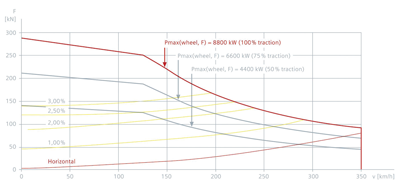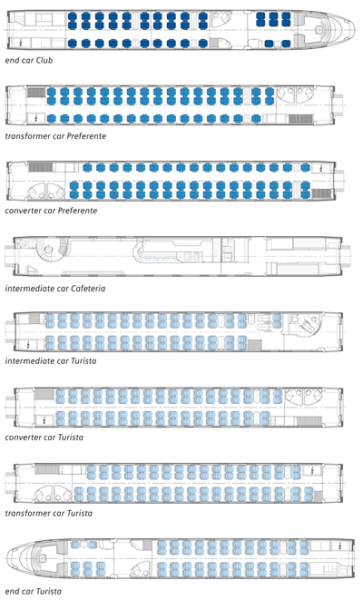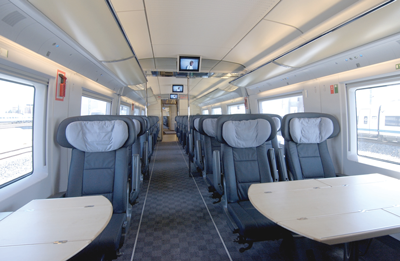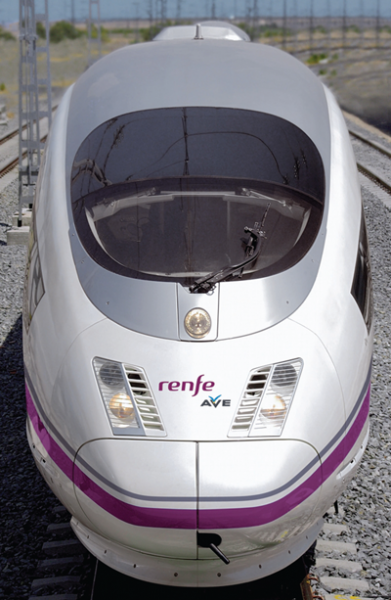Velaro E conquers high-speed in Spain
Posted: 1 August 2008 | | No comments yet
How the Velaro E has met the challenging requirements of the high-speed service in Spain, with a focus on reliability, safety and passenger appeal.
How the Velaro E has met the challenging requirements of the high-speed service in Spain, with a focus on reliability, safety and passenger appeal.
This article describes how the Velaro E meets the challenging requirements of the high-speed service in Spain, especially regarding reliability, safety and passenger appeal.
In 2001 and 2005, Spanish National Railways (Renfe) placed two orders with Siemens for the delivery of a total 26 high-speed trainsets as part of their programme for the development of the high-speed rail services in Spain. The first order marked the start of the development, design and production of Siemens’ new high-speed product platform Velaro® and made the most comfortable and fastest train in Europe become reality, the Velaro for Spain (Velaro E; Renfe’s class AVE S 103). An important milestone in high-speed traffic in Spain was reached on 20 February 2008, with the opening of the 621km-long line between Madrid and Barcelona. The successful start of the passenger service between the two most important Spanish cities represented a groundbreaking milestone in the consequent development of the Siemens platform for high-speed trains. With a total travel time of less than 2 hours and 30 minutes and the exceptional service on board, the Velaro E is offering a really attractive alternative to airlines. As a result, high-speed train service will very soon be a strong competitor to the world’s busiest air route and the first months of operation have already given evidence that the Velaro E high-speed shuttle will become a serious competitor to the Spanish airlines.
Short history of the development of the Velaro E
The first German high-speed train, the ICE® 1, entered revenue service in 1991. Its successor, the ICE 2, soon followed. The ICE 1 features power cars at both ends, thus forming a push-pull train. Whereas the ICE 1 consists of two power cars and 14 intermediate cars, the ICE 2, which is to a large extent technically identical to its predecessor, comprises just one power car, a control car at the other end and six intermediate cars and allows the coupling of two 205m ICE 2 units to form one long trainset.
The development of very high-speed trains based on the principle of electrical multiple units started in Germany. In the early 90s, the ICE D, the first experimental train for the testing of advanced systems and components for high-speed trains, was used to enhance the existing technology from the push-pull-train to the system of distributed traction. Based on this experience, the second experimental train, the ICE S, accommodated the traction systems in the under-frame of a very high-speed train for the first time in Europe. When the third generation of ICE 3 started commercial operation in 2000, an important revolutionary step had been taken toward distributed traction in very high-speed trains. At the beginning of the new millennium, Siemens (as the key player in this long history of technological development) decided to create its own platform for very high-speed trains, the Velaro. The Velaro incorporates a wide range of further adaptations and optimisations compared to the ICE 3. The first train of the Velaro platform, the Velaro E, which entered passenger service successfully in 2007, provides solutions for very challenging requirements, for example a maximum speed of 350km/h and compliance with the Technical Specification for Interoperability (TSI). Two further contracts in China and Russia were awarded to Siemens, underlining the success of the Velaro platform for the international railway market. The first trains of the 60 Velaros for China will start passenger operation shortly before the Olympic Games in Beijing and the eight Velaros for Russia will enter revenue service towards the end of 2009. New requirements such us ultra-low temperatures and the broad gauge in Russia or high density seating and wider car bodies in China mean that the Velaro platform already covers the widest range of specifications to satisfy the needs of railway companies all over the world.
High-speed in Spain
When the first high-speed rail service in Spain started between Madrid and Seville on 21 April 1992, nobody could have foreseen the tremendous development the Spanish railway was about to experience thereafter. It has resulted in the present high-speed services to Malaga, Barcelona, Valladolid and in additional lines which will start as soon as the current construction projects are completed.
After 16 years of successful operation, AVE (Renfe’s high-speed services) is a well known brand, which is recognised for fast reliable railway operation and outstanding onboard service. Many of the standards set by Renfe with the start of the Madrid to Seville line are still unmatched in Europe, for example the punctuality commitment with a money-back guarantee in case of a delay greater than five minutes and the three-class service. The dramatic reduction in travel time in conjunction with the high-quality service standard was of paramount importance for the sharp increase of market share. As a result, the railway has become the uncontested number one choice for passenger travel between Seville and Madrid.
This policy has motivated Renfe from the conception phase of the new high-speed services in Spain to this day. Renfe’s recipe is simple, albeit very challenging: it demands high-end performances from their personnel as well as from all suppliers of trains and services. This recipe is of vital significance especially regarding the service operation between Madrid and Barcelona, where the railway has to compete with the world’s busiest airline route.
This is the motivation behind the Velaro E, a train that is able to travel between Madrid and Barcelona in less than 2 hours and 30 minutes, that is called upon to set new standards in terms of safety and passenger comfort and that meets the most demanding expectations. An important milestone in this process was achieved on 20 February 2008 with the successful launch of 300km/h service between Spain’s two leading cities. And a further improvement is already in sight as Renfe and Siemens are currently working with ADIF (Spain’s infrastructure owner) to homologate ETCS Level 2 as the signalling system between Madrid and Barcelona. ETCS level 2 will allow the Velaro to increase speed from the current maximum of 300km/h (due to ETCS Level 1) to its design speed of 350km/h in revenue service and, as a consequence, reduce the travel time between Madrid and Barcelona even further.
But high-speed plans in Spain represent not only a revolution in connecting privileged cities that have access to the network, but also a strong instrument to facilitate rail travel between regions. For this reason, current plans of the Infrastructure Ministry (Ministerio de Fomento) aim to extend this service to all regions by 2020 (to a total of 10,000km). This network is being built with the standard European track gauge of 1,435mm instead of the Iberian broad gauge used in Spain and Portugal. The arrival of the high-speed services to Barcelona on 20 February 2008 and the progress of the works on the high-speed line between Barcelona and the French border constitute a further step to the historical milestone we are about to see when Spain finally links up to the European railway network with the standard track gauge of 1,435mm.
Train description
The Velaro E is Siemens’ answer to Renfe’s requirements for high-speed service. The Velaro combines a maximum speed of 350km/h – currently making it the world’s fastest series production train – with a unique interior design to offer passengers the best possible travel experience.
A distinctive feature of the Velaro concept is that, technically, it is an electric multiple-unit (EMU) train, i.e. all traction and technical equipment modules are distributed under floor over the length of the train. Consequently, the Velaro E has no locomotives or power cars at the train ends and, therefore, the full length of the train above floor is available for passenger accommodation, offering 20% more room than conventional trains of the same train length and amounting to a total of 405 passengers distributed in three classes: Turista (similar to economy class), Preferente (similar to business class) and Club (a premium first class). Comfort and safety are also guaranteed by service-proven running gear from Siemens, while entertainment is provided by audio and video programmes. Additionally, the train is protected by Siemens train control technology with the advanced European ETCS Levels 1 and 2, as well as the STM LZB for operation on the Madrid to Seville and Madrid to Malaga lines.
The traction concept
Apart from the significant improvement of available passenger space, the EMU philosophy of the Velaro E represents many other operating advantages, such as:
- Half of all axles are driven, i.e. high utilisation of adhesion during acceleration
- Trainset is capable of starting on gradients as steep as 40‰
- Weight is evenly distributed over the entire trainset, i.e. individual axle load is significantly lower than the international standard of 17 tonnes. This reduces track and running gear wear and therefore their maintenance requirements. Additionally, the evenly distributed weight also improves the running characteristics and thus the ride comfort
To accelerate to a speed of 350km/h, the Velaro E develops a traction power of 8,800 kW distributed in four identical, independent traction units. This produces a redundancy of 75%, i.e. if one traction unit fails, it can be disabled without affecting the remaining units.
But even more important than a rapid acceleration is a rapid deceleration. On the Velaro E, the electric brake allows automatic switchover and braking in regenerative and rheostatic modes. Obviously, the regenerative braking mode is preferred in routine service; only when the network is no longer able to absorb the electric braking energy of the traction motors the rheostatic brake is used.
The trainset consists of eight cars numbered C1 to C8, allowing the distribution of passengers in three different classes of very attractive and modern designs (see Figure 4 on page 88).
The C1 houses the driver’s cab and, immediately behind it, the Club class section. A highlight of the design is the seating in the lounge just behind the cab, where a transparent glass wall offers passengers an unobstructed view of the track ahead. The design of this class includes leather seats in a 2 – 1 per row arrangement and large video screens, especially designed for a unique travel experience. This premium service is completed with at-seat catering prepared in a dedicated own galley allocated at the non-cab end of this car. The Club class is followed by the Preferente class in cars C2 and C3. Here, too, passengers can find a high-quality ambience in a 2 – 1 per row seat arrangement and personal service at business class level. The transition between the two top classes and the Turista class area is formed by the Cafeteria car or C4. There are two galleys in this car: one dedicated to cater for the Preferente passengers and the other one to serve passengers in the cafeteria area. This car also accommodates the customer service desk as well as spaces for the train personnel and luggage. Finally, we arrive in the four Turista cars C5 to C8 with their 2 – 2 per row seating arrangement and generous space conditions for passengers. They also feature comfortable areas, seats and toilets for disabled passengers. Here, again, the highlight in C8 is the lounge behind the driver’s cab with the possibility to have an unobstructed view of the track.
Due to the absence of power cars, the Velaro E design thus makes use of the generous space available for passengers consistently throughout all three classes and provides a high-end interior design satisfying the most different tastes.
The train incorporates the tried-and-tested Siemens control technology to guarantee the highest reliability as well as advanced diagnostics to inform the driver and the maintenance personnel of the actual status of all train functions. The data transfer between the different systems distributed along the complete train length is performed via the Train Communication Network (TCN), consisting of the train bus (WTB) and the vehicle bus (MVB). The consistently redundant design of the TCN system provides additional availability of the communication paths. This allows not only a reliable data transfer between the two 4-car traction units of the 8-car train, but also between two coupled trainsets.
To provide a maximum level of comfort for the passengers, the train requires an especially efficient onboard power supply system. Continuous busbars ensure the reliable supply of all electrical loads and auxiliary devices such as fans, pumps, compressors, ovens (several in each galley), lighting, coffee machines, computer power sockets or the communication system.
This onboard system also supplies the power needed for heating, ventilation and air conditioning. In order to maintain the comfort standards also in the hot Spanish summer months, the Velaro E has a redundant air-conditioning system capable of creating the best interior ambiance for passengers even in the hottest summer days. Therefore, the air-conditioning system is designed to operate at outdoor temperatures up to 50°C. And this kind of comfort is also available to the drivers, with a separate air-conditioning system for the cab enabling them to enjoy optimal working conditions.
Passengers also have access to a state-of-the-art information system in all classes via large flat screens, which are clearly visible from every seat and provide exciting video entertainment. Compatibility with the new standardised media formats (e.g. DVD and MP3) offers passengers constant access to the latest productions in top quality. As a result, seven different stereo audio programmes (also including live radio) can be tuned in at every seat. Another very important additional feature is that the video programme shown can be compiled by the train attendants by selecting from the different video channels for each car. This allows the operator to charter complete cars, e.g. for corporate events, offering the operator additional marketing possibilities for the train.
The systems also keep passengers constantly up-to-date with the latest travel information, connections at next stop, etc. as announcements and internal communication can be made from 12 fixed intercom stations. It also offers the possibility of group selective announcements (e.g. for individual cars, classes). Passengers receive information, such as speed and outdoor temperature, via elegant interior and exterior LED displays. And all on a multilingual basis, as information in English, Spanish, French and Catalan is displayed sequentially.
Ride quality
The bogies that are known from the ICE 3 of German Rail contribute to the exemplary ride quality of the Velaro E. They also maximise the stability for excellent running comfort. The world record set at 404km/h by the Velaro E series train clearly demonstrates the exceptional safety and comfort margin offered by this bogie design.
All this has been meticulously reviewed during the homologation process of the train. It has been conceived to comply with the demanding Technical Specification of Interoperability (TSI). Pantographs, brakes, ride quality, safety systems – everything has been analysed and tested according to strict standards under different normal and fault conditions. One highlight of this process is the scrutiny exercised to validate compliance of the train design with the specification for crash and fire scenarios (e.g. its ability to continue operation at 80km/h for 15 minutes) as well as the bodyshell design for pressure-tightness during tunnel passage at very high-speed and for cross-wind stability.
The train length of 200 meters has also been chosen deliberately in view of the requirements of the TSI. It means a train running in double traction can make use of the maximum TSI over total length of 400m. This allows the operator to cater to peak passenger demand on highly frequented routes (e.g. Madrid to Barcelona) or to offer two coupled trainsets to run on one section of a line and then split them up into two trains to head for two different final destinations.
The special care devoted to the train design in order to offer passengers an exclusive ambiance has also been followed in the conception of the driver’s cab: an exceptional work environment. Redundant displays provide the driver with a perfect overview and control of train functions. All handles and switches are in easy reach. Top-class materials, outstanding finishing quality of the fittings, an electrically operated sunblind, an ergonomic seat – everything is designed to offer the driver the best possible working conditions that are unparalleled in the railway industry. Finally, and to leave everyone entering the cab for the first time speechless, the speedometer scaled to 400km/h shows that this cab is designed for the world’s fastest commercial operating train, for a maximum speed of 350km/h shown on a label on the left-hand side of the driver’s console.
Important milestones in the Velaro E project for Spain
The 26 Velaro E trains for the Spanish National Railways (Renfe) were awarded to Siemens in two orders, for 16 trains in July 2001 and for a further 10 trains in December 2005. As of June 2008, 25 trains had been handed over to Renfe and are running successfully in revenue service. The last train will be handed over within the next few months after having finished the pending final homologation trials for the signalling system ETCS Level 2. The following list indicates some of the important milestones of the Velaro E, which is known in Spain under the Renfe class AVE S103:
- June 2005
Start of dynamic train commissioning of train 1 - November 2005
Start of high-speed test trials - January 2006
Start of homologation on track-testing - June 2006
High-speed world record of series train with 404 km/h during test trials - June 2007
Start of passenger service on Madrid to Tarragona and Madrid to Seville lines - December 2007
Start of passenger services on Madrif to Malaga line - February 2008
Start of passenger service on Madrid to Barcelona line
One especially decisive moment in the project was, without a doubt, the inauguration of the Madrid to Barcelona line. The success of this service between the two most important cities in Spain was of particular importance for Renfe. The clear goal from the beginning was and is to win over a significant share of passengers from air traffic. With 971 weekly flight operations between both cities in 2007, this is clearly the world’s busiest air route. The launch of a competitive high-speed train shuttle service was consequently the object of special interest in the Spanish media. Aware of the tremendous responsibility, the last night before the start was a short and virtually sleepless one for all project members. But all of their efforts paid off, as the service proved to be a success from day one. The direct connections between both cities – the 621km are completed within 2 hours 38 minutes – are exceedingly popular among the passengers and have already become the darlings of the Spanish media. According to initial estimations, approximately 100,000 passengers switched from air travel to rail travel in the first month of this service alone. By the end of the second month of service, a respectable number of approximately 20% additional passengers had been won and the market share is expected to be increased significantly within the next months.
In the process, the project team had to face various challenges. The increase in train rides and the respective increase in fleet mileage were tremendous. Starting from a daily average mileage of 10,000km in November 2007, it had to cope with a sharp increase of up to approximately 30,000km in April 2008. The results speak for themselves as, according to Renfe’s figures, the punctuality of the Velaro E in the Madrid to Barcelona operation has been outstanding and, in the first two months, very close to 100%.
Outlook
The high-speed rail service in Spain has developed in the last decade to a remarkable level and is already playing a leading role in Europe. The Velaro E now forms the backbone of Renfe’s most important routes. Nevertheless, there are still a few more steps to be taken.
Currently, the trains are running under the latest signalling system ETCS Level 1 at a maximum operating speed of 300km/h. Although the Velaro E is already homologated for an operating speed of 350km/h, the interaction of the train with the trackside equipment under the ETCS Level 2 still needs to be tested. The final authorisation for the ETCS Level 2 system will be achieved within the coming months. As soon as the operating speed is raised to 350km/h, a further reduction in travel time between Madrid and Barcelona to slightly more than 2 hours will be achieved, thus making the service all the more appealing to passengers.
Another milestone will be the opening of a bypass around Madrid that will connect the Barcelona line to the high-speed lines to the south. Today, Renfe is already offering a journey with the Velaro E trains between Barcelona and Malaga and Seville, respectively. Both routes can now be completed in 6 hours and 30 minutes, including a longer stop in Madrid. As soon as the bypass is opened, direct rides will be offered and will mark an astonishing milestone in the railroad history of Europe. Both routes covering more than 1,100km could be completed within approximately 5 hours alone.
Finally, it can be concluded that the Velaro platform with its first application in Spain has proven its capability to meet customers’ needs. The Velaro E successfully copes with the challenging requirements for high-speed service in Spain and has set new quality standards in rail travel. As a forerunner for its successors in China and Russia and other countries in the future, the Velaro E will furthermore be a source of continuous experience, feedback for further and consistent optimisation of the Velaro platform for the sake of our clients and for the benefit of train passengers.


Figure 1: Development of high-speed trains - from push pull trains to distributed traction


Figure 2: Traction concept of the Velaro E


Figure 3: Tractive effort diagram


Figure 4: Layout of the Velaro E


Figure 4: Club Car C1


Figure 6: Velaro E on track in Spain


